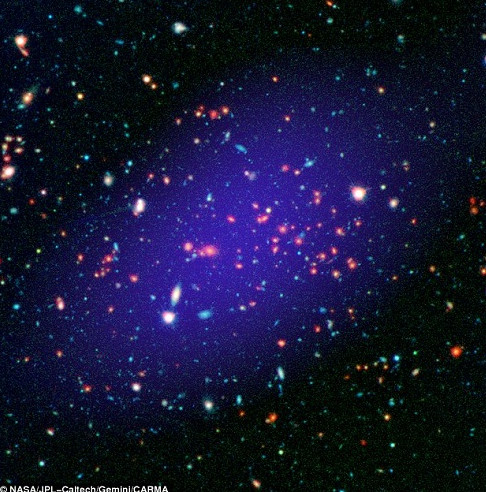Detecting giant galaxy cluster 8.5 billion light-years from Earth
Astronomers have discovered a huge collection of galaxies in the extremely remote region of the universe thanks to NASA's Spitzer space telescope and Wide-field Infrared Survey Explorer (WISE).
The collection of galaxies about 8.5 billion light-years from Earth is the largest structure ever found at such a long distance. This collection contains thousands of galaxies, each one containing hundreds of billions of stars.
Galaxies grow with time as new members are added. Peter Eisenhardt, NASA scientist, co-author of the report, said: ' Based on our understanding of galaxy clusters growing in the universe, this is one of the five largest assemblies that exist'. .

Giant galaxy cluster.
The discovery of a giant galaxy cluster called MOO J1142 + 1527 existed about 8.5 billion years ago from Earth. The red galaxies in the center of the image, are the center of the galaxy cluster.
In 2016, the team plans to screen for the largest galaxy in the set.'Once we find the largest cluster of galaxies, we can begin to look at the evolution of galaxies in harsh environments,' said Gonzalez, a member of the research team.
Because light takes time to reach Earth, we can see things as far as they exist in the past.
For example, we are seeing clusters of newly discovered galaxies - known as Massive Object Overdense (MOO) J1142 + 1527 - that existed about 8.5 billion years ago, long before Earth was formed.
In the images obtained from Spitzer telescopes, distant galaxies in red, whichever is closer will be white.
According to scientists, the set of galaxies MOO J1142 + 1527 may be one of the few galactic clusters that appeared ancient from the beginning when the universe was formed.
- The galaxy cluster is 500 billion billion times heavier than the Sun.
- The early galaxy cluster is 12.4 billion light-years away from Earth
- The galaxy cluster has three million billion times the mass of the Sun.
- Find the oldest cluster of galaxies
- Detecting spiral galaxies in the early universe
- Galaxy Fairy Women will swallow our Milky Way?
- Discovering a black hole 40 billion times larger than the Sun.
- 4 galaxy clusters collide 3 billion light-years from Earth
- The galaxy is 13.28 billion light-years from Earth
- The giant galaxy is 12.5 billion light-years from Earth
- Discover the most distant galaxy group
- Telescope 'travel' back in time 13.2 billion years
 Van Allen's belt and evidence that the Apollo 11 mission to the Moon was myth
Van Allen's belt and evidence that the Apollo 11 mission to the Moon was myth The levels of civilization in the universe (Kardashev scale)
The levels of civilization in the universe (Kardashev scale) Today Mars, the sun and the Earth are aligned
Today Mars, the sun and the Earth are aligned The Amazon owner announced a secret plan to build a space base for thousands of people
The Amazon owner announced a secret plan to build a space base for thousands of people James Webb Telescope captures stunning images of 19 spiral galaxies
James Webb Telescope captures stunning images of 19 spiral galaxies  'Time travel' 13.5 billion years, NASA telescope finds 4 cosmic ancestors
'Time travel' 13.5 billion years, NASA telescope finds 4 cosmic ancestors  Hubble telescope captures image of 'bridge' connecting two galaxies
Hubble telescope captures image of 'bridge' connecting two galaxies  Find out what created the most bizarre super objects in the universe
Find out what created the most bizarre super objects in the universe  Revealing 3 'red monsters' that overturn the laws of cosmic evolution
Revealing 3 'red monsters' that overturn the laws of cosmic evolution  NASA captures for the first time 4 objects that travel through space 13.4 billion years, the oldest in the universe
NASA captures for the first time 4 objects that travel through space 13.4 billion years, the oldest in the universe 